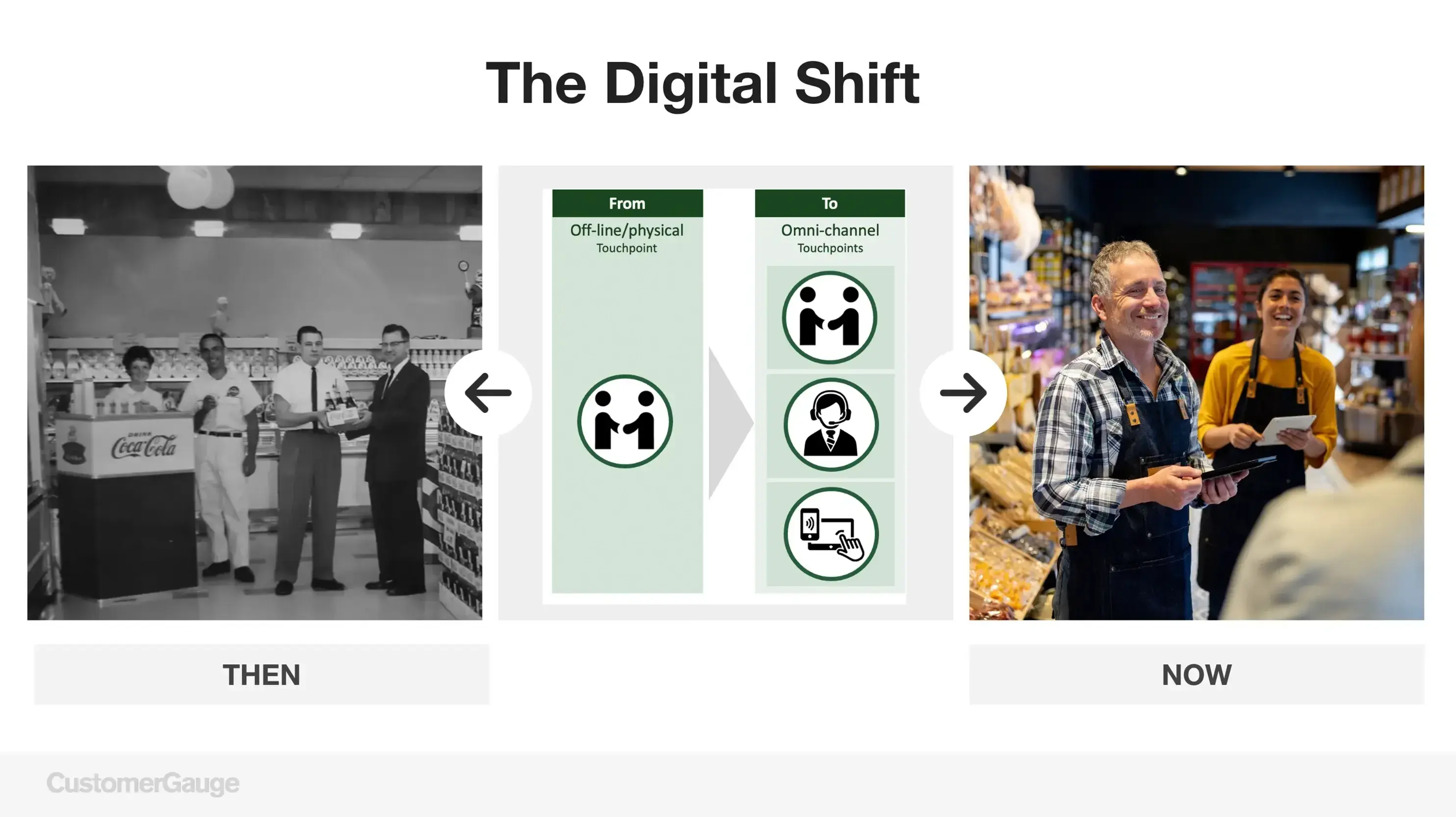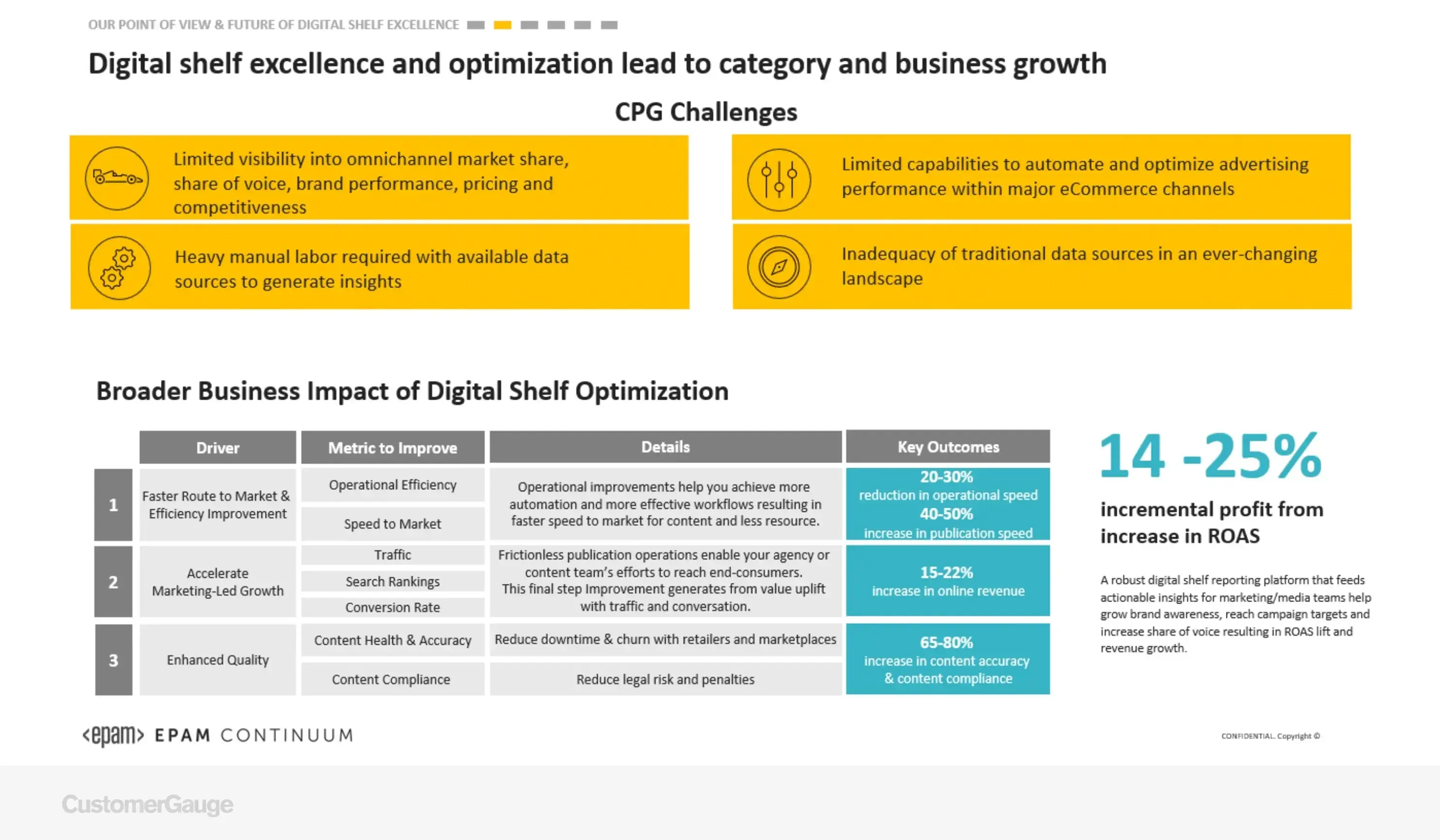The Consumer Packaged Goods (CPG) industry is always rapidly changing. New challenges arise, operations advance and technology finds a way to play a critical role.
And in a market as competitive as CPG, businesses are no longer looking for ways to keep up.
Companies want to understand what's next to get ahead of the competition and know exactly which areas to invest in.
Today, that area is digital transformation.
It was estimated CPG manufacturers spent $23.8 billion on digital transformation in 2023 alone — safe to say this is no longer just a trend.
That's why our CEO & Co-Founder Adam Dorrell welcomed three industry experts to The CPG Digital Transformation Summit to break down the current state of CPG and to understand what is required to successfully plan for our new omnichannel reality moving forward.
On-screen alongside Adam was Frederik van Os, Vice President of CPG customer experience (CX) at CustomerGauge, Vitaliy Novikov, Group Digital Commerce Director at Coca-Cola HBC, and Mert Damlapinar, Managing Principal of CPG Digital Commerce at EPAM Systems.
The four dove straight into an engaging conversation on how to navigate digital transformation through the lens of their three areas of expertise: customer experience, the supply chain, and the digital shelf.
The CPG Technology Timeline + Omnichannel Touchpoint Strategy
Each panelist brought different experiences to the table that made for an engaging discussion.
We kicked off with Frederik van Os sharing his background of working in both remote Congo and Nigeria, where he operated in traditional "grassroots" ways of doing business.
He spent 12 years at Heineken having been a part of both regional and global roles leading to his latest position as VP of CPG CX at CustomerGauge.
Before making his way into the world of CX, he was involved in advanced analytics and artificial intelligence (AI).
Frederik's career has given him a fantastic perspective on previous operations compared to the new digital agenda.
When looking at the timeline, digital transformation doesn't necessarily look as extreme as it sounds on its own. CPG has been constantly evolving, and we are now entering another era as we always have.
Frederik continued,
"I think there is another transition worth mentioning, this marketing era where there is a real hard focus on brand equity. There is now a groundbreaking study that was offered by Bain and Company: the biggest contributor to brand growth wasn't brand equity, it was penetration.
It really goes to show that what you saw happening there was a big shift from purely looking at the consumer rather than looking at the consumer and the customer in terms of driving value."
Moving into today's setting, the panel agreed this is a story that relates to every CPG business.
Adam and Frederik transitioned next into the digital shift and what it means to stray away from the traditional touchpoint strategy to the new omnichannel reality.
"The picture on the left is the classic single touchpoint. If you're a customer, you see the vending salesmen bring out the product. Today, we have these omnichannel touchpoints where customers can call contact centers, and have a digital experience, and a physical experience.
It's how you orchestrate this new reality and complexity that makes the difference between winning and losing." said Frederik.

Adam prompted that if customer experience is the lens to look through to the digital shift, how does Frederik see the future of this transformation unfolding?
What have been failures already made by CPG companies?
What are they missing?
Frederik finished by breaking down the disruption to the route to market. The route to market differs from market to market and is one of the main areas that are at risk of being disrupted by the digital shift.
Why? Customer needs are evolving due to quick and easy ordering solutions (for example, Amazon) on their smartphones.
And worldwide, we're already seeing some big players run up against competition due to "Amazonification," a concept we cover deeply in our CPG Experience Benchmarks Report.
Digital Transformation's Impact on Supply Chain
Our next panelist was Vitaliy Novikov, Group Digital Commerce Director at Coca-Cola HBC.
Vitaliy brings more than 18 years of experience to The Summit working in FMCG at not only Coca-Cola HBC but Johnson & Johnson and Henkel.
His area of expertise is CPG supply chain, where he provided insights into what changes we can expect to it.
Vitaliy began by sharing a great reminder of what not to lose sight of the day-to-day while navigating digital transformation.
"Digital transformation is bringing us closer to consumers — it's called CPG for a reason. I keep telling my team while we are digital, we sell beverages that are physical and consumers are physical, too."
For Vitaliy, technology is opening new doors to businesses enabling better service to customers and faster and more innovative with consumers.
However, he doesn't think the nature of what CPG companies do: giving good products and services to customers is changing.
"Our DNA remains what it was, and I believe this will not change even with digital transformation."
Where do you start to see the biggest challenges? Where should people invest?
It's all about connecting the silos of data.
Adam went on to ask if there is an added complexity in the way CPG companies report their data.
Vitaliy answered with how the majority of CPG companies are B2B, meaning they aren't selling directly to consumers even though their success ultimately depends on consumers being excited about purchasing their products.
What does a 'good' digital transformation strategy encompass?
What does a 'not so good' strategy look like?
How the Digital Shelf Is Being Affected
Our fourth panelist was Mert Damlapinar, Managing Principal of CPG Digital Commerce at EPAM Systems.
Mert has experience working for well-known brands like L’Oreal, Mondelez, and Sabra/PepsiCo. His expertise is the digital shelf, making for a unique point of view to The Summit's discussion.
The digital shelf is a much more interactive landscape than compared to the offline channel.
"It's not infinite — there are many levers that retailers and marketplaces can pull in terms of reach out and engagement to consumers.
As you journey from a physical retail store to your mobile phone, smart devices, and even voice-activated devices, you reduce from one thousand SKUs on a traditional supermarket aisle platform to one product on your Amazon Echo device.

Mert continued,
"This makes the digital shelf much more challenging. And what I see in the environment right now are trending technologies where CPGs and retailers are investing and enhancing the digital shelf or digital content supply chain.
The other one is about how different components and operations in the brand CPG environment have to collaborate. So, the digital shelf is a very, very nimble and versatile tool."
How is digital transforming omnichannel and point of sale?
Amazon: Ally or Competitor?
We wrapped up The CPG Digital Transformation Summit with an open Q&A to share final insights.
The four continued to deliver actionable insights on how to navigate digital transformation through the lens of customer experience, the supply chain, and the digital shelf.
The Industry Is Digitalizing Whether You're Ready for It or Not
CPG is facing one of the biggest shifts yet: digital transformation.
However, we're seeing most CPG companies fall behind in embracing the new digital agenda compared to other industries — why?
The scale and complexity of CPG operations while navigating supply chain issues, labor shortages, and more have slowed innovation.
However, it's going to be those eager to learn how to leverage this shift who will surpass the competition and grow market share this year.
Ready to see how the top brands in CPG are advancing through modern technology?
👉 Reach out to our team to learn more or see our Account Experience (AX) solution live!
Full Summit Video
Looking to watch back The CPG Digital Transformation Summit from the start? The full recording is below.

